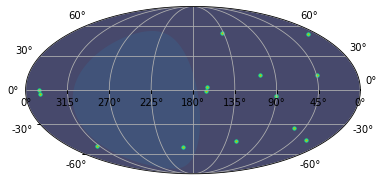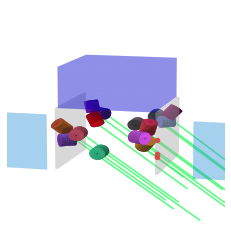GBM Geometry Demo¶
gbmeometry is a module with routines for handling GBM geometry. It performs a few tasks: * creates an astropy coordinate frame for Fermi GBM given a quarternion and spacecraft position * allows for coordinate transforms from Fermi frame to an astropy frame (J2000, etc.) * plots the GBM NaI detectors at a given time for a given FOV * determines if an astropy SkyCoord location is within a NaI’s FOV * creates interpolations over GBM quarternions and SC coordinates
[1]:
%matplotlib inline
from astropy.coordinates import SkyCoord
import astropy.coordinates as coord
import astropy.units as u
from gbmgeometry import *
from gbmgeometry.utils.package_utils import get_path_of_data_file
Interpolating the spacecraft position¶
First let’s create an interpolating object for a given TRIGDAT file (POSHIST files are also readable)
[2]:
interp = PositionInterpolator.from_trigdat(get_path_of_data_file("glg_trigdat_all_bn080916009_v02.fit"))
The quaternion and sc_pos functions can take as inputs the time since trigger
[3]:
#
print ("Quaternions")
print (interp.quaternion(0))
print (interp.quaternion(10))
print
print ("SC XYZ")
print (interp.sc_pos(0))
print (interp.sc_pos(10))
Quaternions
[0.09894184 0.81399423 0.56763536 0.07357984]
[0.09651158 0.81315938 0.56970097 0.06998621]
SC XYZ
[3184.75 5985.5 1456.75]
[3111.77432458 6015.91372132 1488.98009345]
Single GBM detector properties¶
One can look at a single detector which knows about it’s orientation in the Fermi SC coordinates as well as where it is currently pointing on its optical axis in J2000. In fact, since the GBM frame is part of the astropy coordinate family, it can be transformed into any system!
[4]:
interp.quaternion(1)
[4]:
array([0.0986775 , 0.81390325, 0.56786244, 0.07318777])
[5]:
na = NaIA(interp.quaternion(1))
print (na.center)
print (na.center_icrs) #J2000
print (na.center.galactic) # Galactic
print ("Changing in time")
na.set_quaternion(interp.quaternion(100))
print (na.center)
print (na.center_icrs) #J2000
print (na.center.galactic) # Galactic
<SkyCoord (GBMFrame: sc_pos_X=None, sc_pos_Y=None, sc_pos_Z=None, quaternion_1=0.09867749622828526, quaternion_2=0.8139032523975553, quaternion_3=0.5678624418045289, quaternion_4=0.07318777342560503): (lon, lat) in deg
(123.73, -0.42)>
<SkyCoord (ICRS): (ra, dec) in deg
(12.8426513, 51.9249513)>
<SkyCoord (Galactic): (l, b) in deg
(122.92135609, -10.94679491)>
Changing in time
<SkyCoord (GBMFrame: sc_pos_X=None, sc_pos_Y=None, sc_pos_Z=None, quaternion_1=0.07365115360430513, quaternion_2=0.8058104624624784, quaternion_3=0.5863608294681484, quaternion_4=0.037717550642801925): (lon, lat) in deg
(123.73, -0.42)>
<SkyCoord (ICRS): (ra, dec) in deg
(14.14827804, 51.13038764)>
<SkyCoord (Galactic): (l, b) in deg
(123.75793083, -11.73309177)>
We can also go back into the GBMFrame¶
[6]:
center_j2000 = na.center_icrs
center_j2000
[6]:
<SkyCoord (ICRS): (ra, dec) in deg
(14.14827804, 51.13038764)>
[7]:
center_j2000.transform_to(GBMFrame(**interp.quaternion_dict(100.)))
[7]:
<SkyCoord (GBMFrame: sc_pos_X=None, sc_pos_Y=None, sc_pos_Z=None, quaternion_1=0.07365115360430513, quaternion_2=0.8058104624624784, quaternion_3=0.5863608294681484, quaternion_4=0.037717550642801925): (lon, lat) in deg
(123.73020963, -0.4198826)>
Earth Centered Coordinates¶
The sc_pos are Earth centered coordinates (in km for trigdat and m for poshist) and can also be passed. It is a good idea to specify the units!
[8]:
na = NaIA(interp.quaternion(0),interp.sc_pos(0)*u.km)
na.get_center()
[8]:
<SkyCoord (GBMFrame: sc_pos_X=3184.75 km, sc_pos_Y=5985.5 km, sc_pos_Z=1456.75 km, quaternion_1=0.09894184023141861, quaternion_2=0.8139942288398743, quaternion_3=0.5676353573799133, quaternion_4=0.07357984036207199): (lon, lat) in deg
(123.73, -0.42)>
Working with the GBM class¶
Ideally, we want to know about many detectors. The GBM class performs operations on all detectors for ease of use. It also has plotting capabilities.
[9]:
myGBM = GBM(interp.quaternion(0),sc_pos=interp.sc_pos(0)*u.km)
We can either plot the detectors with a field of view:
[10]:
myGBM.plot_detector_pointings(fov=10);

or just where the optical axis is pointing
[11]:
myGBM.plot_detector_pointings(c='y', alpha=1,s=10);

[12]:
myGBM.plot_detector_pointings(fov=10, facecolor='r', projection = "astro globe", center = SkyCoord(30, -30, unit='deg', frame="icrs"), show_earth=False);

[13]:
myGBM.get_centers()
[13]:
[<SkyCoord (GBMFrame: sc_pos_X=3184.75 km, sc_pos_Y=5985.5 km, sc_pos_Z=1456.75 km, quaternion_1=0.09894184023141861, quaternion_2=0.8139942288398743, quaternion_3=0.5676353573799133, quaternion_4=0.07357984036207199): (lon, lat) in deg
(45.89, 69.42)>,
<SkyCoord (GBMFrame: sc_pos_X=3184.75 km, sc_pos_Y=5985.5 km, sc_pos_Z=1456.75 km, quaternion_1=0.09894184023141861, quaternion_2=0.8139942288398743, quaternion_3=0.5676353573799133, quaternion_4=0.07357984036207199): (lon, lat) in deg
(45.11, 44.69)>,
<SkyCoord (GBMFrame: sc_pos_X=3184.75 km, sc_pos_Y=5985.5 km, sc_pos_Z=1456.75 km, quaternion_1=0.09894184023141861, quaternion_2=0.8139942288398743, quaternion_3=0.5676353573799133, quaternion_4=0.07357984036207199): (lon, lat) in deg
(58.44, -0.21)>,
<SkyCoord (GBMFrame: sc_pos_X=3184.75 km, sc_pos_Y=5985.5 km, sc_pos_Z=1456.75 km, quaternion_1=0.09894184023141861, quaternion_2=0.8139942288398743, quaternion_3=0.5676353573799133, quaternion_4=0.07357984036207199): (lon, lat) in deg
(314.87, 44.76)>,
<SkyCoord (GBMFrame: sc_pos_X=3184.75 km, sc_pos_Y=5985.5 km, sc_pos_Z=1456.75 km, quaternion_1=0.09894184023141861, quaternion_2=0.8139942288398743, quaternion_3=0.5676353573799133, quaternion_4=0.07357984036207199): (lon, lat) in deg
(303.15, -0.27)>,
<SkyCoord (GBMFrame: sc_pos_X=3184.75 km, sc_pos_Y=5985.5 km, sc_pos_Z=1456.75 km, quaternion_1=0.09894184023141861, quaternion_2=0.8139942288398743, quaternion_3=0.5676353573799133, quaternion_4=0.07357984036207199): (lon, lat) in deg
(3.35, 0.03)>,
<SkyCoord (GBMFrame: sc_pos_X=3184.75 km, sc_pos_Y=5985.5 km, sc_pos_Z=1456.75 km, quaternion_1=0.09894184023141861, quaternion_2=0.8139942288398743, quaternion_3=0.5676353573799133, quaternion_4=0.07357984036207199): (lon, lat) in deg
(224.93, 69.57)>,
<SkyCoord (GBMFrame: sc_pos_X=3184.75 km, sc_pos_Y=5985.5 km, sc_pos_Z=1456.75 km, quaternion_1=0.09894184023141861, quaternion_2=0.8139942288398743, quaternion_3=0.5676353573799133, quaternion_4=0.07357984036207199): (lon, lat) in deg
(224.62, 43.82)>,
<SkyCoord (GBMFrame: sc_pos_X=3184.75 km, sc_pos_Y=5985.5 km, sc_pos_Z=1456.75 km, quaternion_1=0.09894184023141861, quaternion_2=0.8139942288398743, quaternion_3=0.5676353573799133, quaternion_4=0.07357984036207199): (lon, lat) in deg
(236.61, 0.03)>,
<SkyCoord (GBMFrame: sc_pos_X=3184.75 km, sc_pos_Y=5985.5 km, sc_pos_Z=1456.75 km, quaternion_1=0.09894184023141861, quaternion_2=0.8139942288398743, quaternion_3=0.5676353573799133, quaternion_4=0.07357984036207199): (lon, lat) in deg
(135.19, 44.45)>,
<SkyCoord (GBMFrame: sc_pos_X=3184.75 km, sc_pos_Y=5985.5 km, sc_pos_Z=1456.75 km, quaternion_1=0.09894184023141861, quaternion_2=0.8139942288398743, quaternion_3=0.5676353573799133, quaternion_4=0.07357984036207199): (lon, lat) in deg
(123.73, -0.42)>,
<SkyCoord (GBMFrame: sc_pos_X=3184.75 km, sc_pos_Y=5985.5 km, sc_pos_Z=1456.75 km, quaternion_1=0.09894184023141861, quaternion_2=0.8139942288398743, quaternion_3=0.5676353573799133, quaternion_4=0.07357984036207199): (lon, lat) in deg
(183.74, -0.32)>,
<SkyCoord (GBMFrame: sc_pos_X=3184.75 km, sc_pos_Y=5985.5 km, sc_pos_Z=1456.75 km, quaternion_1=0.09894184023141861, quaternion_2=0.8139942288398743, quaternion_3=0.5676353573799133, quaternion_4=0.07357984036207199): (lon, lat) in deg
(0., 0.)>,
<SkyCoord (GBMFrame: sc_pos_X=3184.75 km, sc_pos_Y=5985.5 km, sc_pos_Z=1456.75 km, quaternion_1=0.09894184023141861, quaternion_2=0.8139942288398743, quaternion_3=0.5676353573799133, quaternion_4=0.07357984036207199): (lon, lat) in deg
(180., 0.)>]
[14]:
[x.icrs for x in myGBM.get_centers()]
[14]:
[<SkyCoord (ICRS): (ra, dec) in deg
(90.02053912, -5.02944102)>,
<SkyCoord (ICRS): (ra, dec) in deg
(106.9639318, 13.09532427)>,
<SkyCoord (ICRS): (ra, dec) in deg
(137.09793576, 52.86180786)>,
<SkyCoord (ICRS): (ra, dec) in deg
(121.3144115, -45.95986919)>,
<SkyCoord (ICRS): (ra, dec) in deg
(194.28783066, -52.03023808)>,
<SkyCoord (ICRS): (ra, dec) in deg
(164.65699738, 2.70662314)>,
<SkyCoord (ICRS): (ra, dec) in deg
(58.29477735, -33.54731071)>,
<SkyCoord (ICRS): (ra, dec) in deg
(28.32615836, -45.28243674)>,
<SkyCoord (ICRS): (ra, dec) in deg
(318.5160438, -51.24281778)>,
<SkyCoord (ICRS): (ra, dec) in deg
(44.56221395, 13.56776347)>,
<SkyCoord (ICRS): (ra, dec) in deg
(12.83264883, 51.9340734)>,
<SkyCoord (ICRS): (ra, dec) in deg
(344.24965886, -2.97248228)>,
<SkyCoord (ICRS): (ra, dec) in deg
(165.84085686, -0.42750824)>,
<SkyCoord (ICRS): (ra, dec) in deg
(345.84085686, 0.42750824)>]
Source/Detector Separation¶
We can even look at the separation angles for the detectors and a source.
[15]:
grb = SkyCoord(ra=130.,dec=-45 ,frame='icrs', unit='deg')
seps = myGBM.get_separation(grb)
seps
[15]:
n0 53.005218
n1 61.732524
n2 98.051083
n3 6.161940
n4 41.739311
n5 56.797086
n6 54.847311
n7 66.309967
n8 83.475797
n9 96.385021
na 139.092757
nb 123.163854
b0 54.656741
b1 125.343259
dtype: float64
Fermi plotting and computing blockage¶
Simple plotting¶
It is possible to plot a 3D model of Fermi that is to scale:
[16]:
from gbmgeometry.spacecraft.fermi import *
f = Fermi(quaternion=interp.quaternion(0) , sc_pos=interp.sc_pos(0))
f.plot_fermi(color_dets_different=True, plot_det_label=False);

computing intersections¶
It is sometimes required to see if photons from a GRB are blocked by spacecraft parts for a given detector. We can test this with the Fermi object:
[17]:
f.add_ray(ray_coordinate=grb)
we can specify to compute for a subset of detectors
[18]:
f.compute_intersections("n1","n2")
[18]:
OrderedDict([('n1',
OrderedDict([(0,
OrderedDict([('surface', ['LAT Radiator+ -y']),
('point',
[array([81.46506793, 96.2 , 41.55346871])]),
('distance',
[43.19931864505643])]))])),
('n2',
OrderedDict([(0,
OrderedDict([('surface', ['LAT Radiator+ -y']),
('point',
[array([77.03030294, 96.2 , 49.26398105])]),
('distance',
[70.33735217701951])]))]))])
or compute for all detectors
[19]:
f.compute_intersections()
[19]:
OrderedDict([('n0',
OrderedDict([(0,
OrderedDict([('surface', ['LAT Radiator+ -y']),
('point',
[array([82.84222535, 96.2 , 86.97456421])]),
('distance',
[29.16877080456398])]))])),
('n1',
OrderedDict([(0,
OrderedDict([('surface', ['LAT Radiator+ -y']),
('point',
[array([81.46506793, 96.2 , 41.55346871])]),
('distance',
[43.19931864505643])]))])),
('n2',
OrderedDict([(0,
OrderedDict([('surface', ['LAT Radiator+ -y']),
('point',
[array([77.03030294, 96.2 , 49.26398105])]),
('distance',
[70.33735217701951])]))])),
('n3',
OrderedDict([(0,
OrderedDict([('surface', []),
('point', []),
('distance', [])]))])),
('n4',
OrderedDict([(0,
OrderedDict([('surface', []),
('point', []),
('distance', [])]))])),
('n5',
OrderedDict([(0,
OrderedDict([('surface', []),
('point', []),
('distance', [])]))])),
('n6',
OrderedDict([(0,
OrderedDict([('surface', []),
('point', []),
('distance', [])]))])),
('n7',
OrderedDict([(0,
OrderedDict([('surface', []),
('point', []),
('distance', [])]))])),
('n8',
OrderedDict([(0,
OrderedDict([('surface', []),
('point', []),
('distance', [])]))])),
('n9',
OrderedDict([(0,
OrderedDict([('surface', []),
('point', []),
('distance', [])]))])),
('na',
OrderedDict([(0,
OrderedDict([('surface', []),
('point', []),
('distance', [])]))])),
('nb',
OrderedDict([(0,
OrderedDict([('surface', []),
('point', []),
('distance', [])]))])),
('b0',
OrderedDict([(0,
OrderedDict([('surface', []),
('point', []),
('distance', [])]))])),
('b1',
OrderedDict([(0,
OrderedDict([('surface', []),
('point', []),
('distance', [])]))]))])
Finally, we can plot this
[20]:
f.plot_fermi(color_dets_different=True, plot_det_label=False, with_intersections=True, with_rays=True);

[ ]: